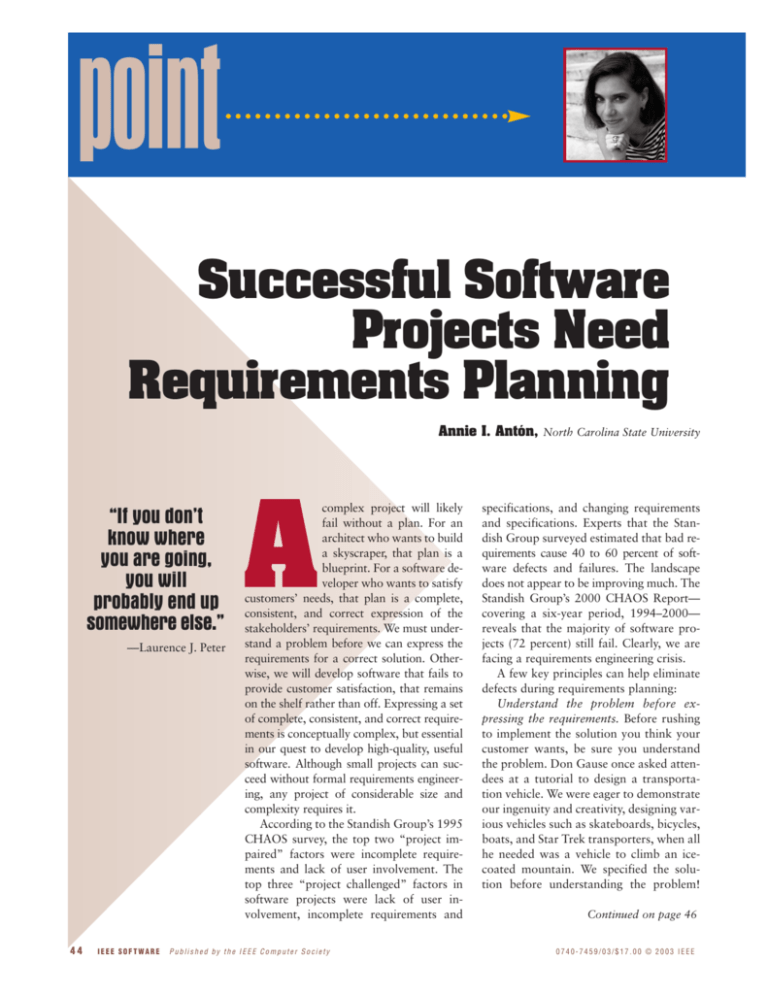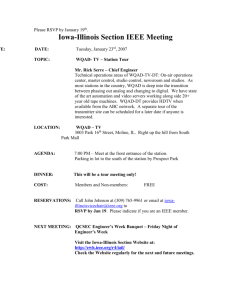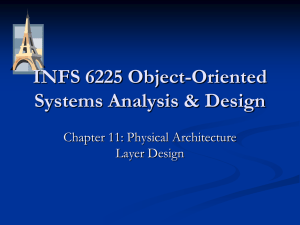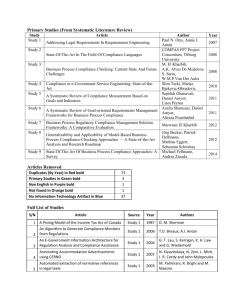Successful software projects need requirements planning
advertisement

point Successful Software Projects Need Requirements Planning Annie I. Antón, North Carolina State University “If you don’t know where you are going, you will probably end up somewhere else.” —Laurence J. Peter 44 IEEE SOFTWARE A complex project will likely fail without a plan. For an architect who wants to build a skyscraper, that plan is a blueprint. For a software developer who wants to satisfy customers’ needs, that plan is a complete, consistent, and correct expression of the stakeholders’ requirements. We must understand a problem before we can express the requirements for a correct solution. Otherwise, we will develop software that fails to provide customer satisfaction, that remains on the shelf rather than off. Expressing a set of complete, consistent, and correct requirements is conceptually complex, but essential in our quest to develop high-quality, useful software. Although small projects can succeed without formal requirements engineering, any project of considerable size and complexity requires it. According to the Standish Group’s 1995 CHAOS survey, the top two “project impaired” factors were incomplete requirements and lack of user involvement. The top three “project challenged” factors in software projects were lack of user involvement, incomplete requirements and Published by the IEEE Computer Society specifications, and changing requirements and specifications. Experts that the Standish Group surveyed estimated that bad requirements cause 40 to 60 percent of software defects and failures. The landscape does not appear to be improving much. The Standish Group’s 2000 CHAOS Report— covering a six-year period, 1994–2000— reveals that the majority of software projects (72 percent) still fail. Clearly, we are facing a requirements engineering crisis. A few key principles can help eliminate defects during requirements planning: Understand the problem before expressing the requirements. Before rushing to implement the solution you think your customer wants, be sure you understand the problem. Don Gause once asked attendees at a tutorial to design a transportation vehicle. We were eager to demonstrate our ingenuity and creativity, designing various vehicles such as skateboards, bicycles, boats, and Star Trek transporters, when all he needed was a vehicle to climb an icecoated mountain. We specified the solution before understanding the problem! Continued on page 46 0740-7459/03/$17.00 © 2003 IEEE point continued from page 44 Similarly, we have a tendency to develop the software we think the customer should want rather than what the customer actually needs. Involve stakeholders early on and sustain their involvement to validate requirements. Requirements are inherently ambiguous, and stakeholders play a key role in helping us disambiguate our understanding of the problem. User involvement goes beyond initial requirements elicitation. We must give customers repeated opportunities to validate requirements. Prototypes provide one method of user involvement because they give users a tangible product to interact with before we completely specify the requirements. By providing prototypes, we ensure that stakeholders see the product at various development stages. Ensure that critical requirements are considered. It’s easy to overlook the critical requirements that can cause systems to fail. Several techniques, including scenario analysis1 and obstacle analysis,2 have helped analysts dis- cover exceptional cases and critical requirements. Such techniques force analysts to envisage scenarios that might block or thwart the achievement of system requirements and goals. For example, by asking “what if” questions, we can envision events––such as power failures or operator errors—that could result in unhandled exceptions and failures. Researchers are developing tools to help analysts avoid overlooking critical requirements, increasing requirements coverage. Give nonfunctional and quality requirements as much attention as functional requirements. Users emphasize functional requirements because they often focus on behaviors they expect the software to exhibit to support their work. However, a software system’s success also depends on nonfunctional and quality requirements. Nonfunctional requirements express a software system’s properties, including security, reliability, portability, and robustness. Given our increasing concern about our systems’ integrity and the informa- continued from page 45 rics as we solve the problem, each dollar spent gives us a better estimate. We’re not stuck with an estimate based on a fictitious solution. By not creating and describing a candidate solution, we save enough money to create a working prototype that will tell us far more about feasibility and cost than some document. Sometimes we get lucky while creating our requirements document by predicting the solution in advance. We begin to believe that if we just put a little more effort into requirements gather46 IEEE SOFTWARE O rganizations can improve their requirements’ quality and subsequently their software by adopting good requirements engineering practices. Moreover, good requirements planning means software can be cheaper to produce, easier to build, and less prone to unexpected failure. References 1. C. Potts, K. Takahashi, and A.I. Antón, “Inquiry-Based Requirements Analysis,” IEEE Software, vol. 11, no. 2, Mar./Apr. 1994, pp. 21–32. 2. A. van Lamsweerde and E. Letier, “Integrating Obstacles in Goal-Driven Requirements Engineering,” Proc. 20th Int’l Conf. Software Eng. (ICSE 98), IEEE CS Press, 1998, pp. 53–62. Annie I. Antón is an assistant professor in the College of Engineering at North Carolina State University. Her research interests include the specification of complete, correct behavior of software systems used in environments that pose risks of loss as a consequence of failures and misuse. Contact her at aianton@ eos.ncsu.edu. counterpoint ing we can guess correctly every time. Unfortunately, the cost of a rigorous enough process for an accurate guess is far greater than most projects can afford. So instead, take the opposite path and do less. Spend customers’ time wisely by reviewing partial solutions with them and having them help solve the problem. Think about just-in-time requirements gathering, which asks only for details that we can use immediately. Anything more is wasteful. Query for details instead of creating a complete h t t p : / / c o m p u t e r. o r g / s o f t w a r e tion they store, we must sufficiently analyze these requirements; otherwise, our requirements will not be complete or correct. catalog in advance. If we must stop or change direction, we haven’t wasted time cataloging details that aren’t used. This resembles lean manufacturing and just-in-time parts supply (see www.poppendieck.com). Y ou can solve most software problems with a few broad steps. Find out enough about the problem to estimate the cost of solving it. Always plan to do what is most important next; this usually yields breadth-first construction. Never invest in some-











